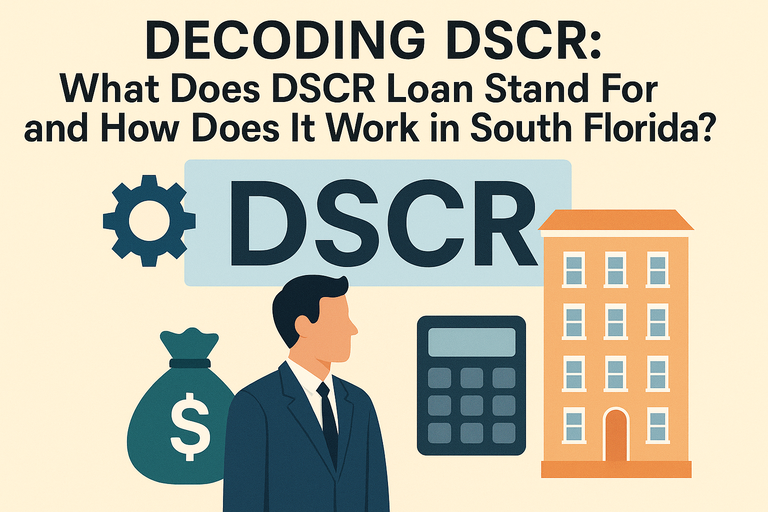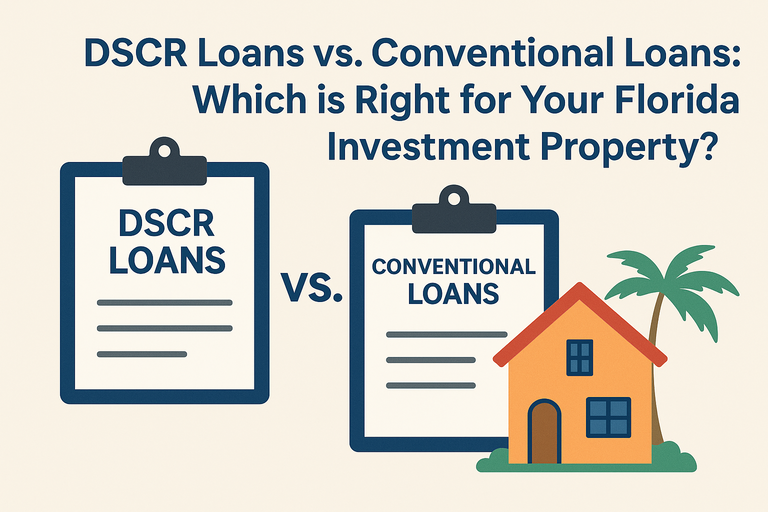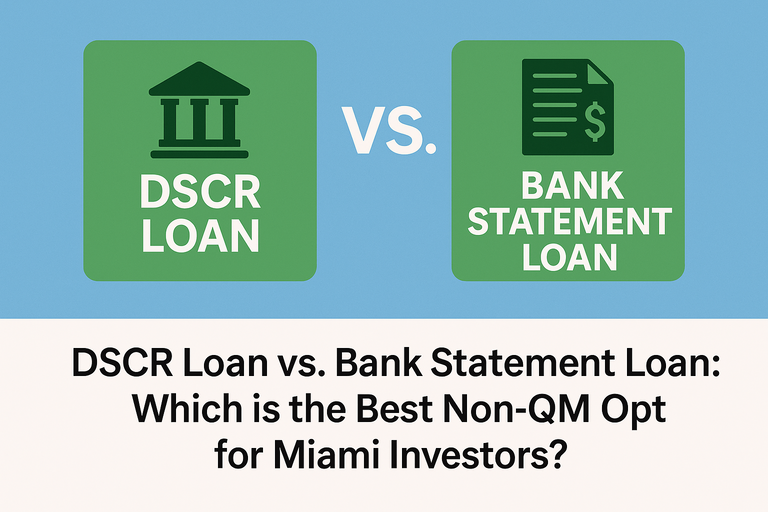South Florida’s real estate market has become a magnet for real estate investors seeking strong returns from both long-term rentals and lucrative vacation properties. As investors explore financing options beyond traditional mortgages, one term keeps appearing: DSCR loans. But what does DSCR loan stand for, and why are these loans becoming the go-to choice for savvy South Florida investors?
What Does DSCR Loan Stand For?
DSCR stands for Debt Service Coverage Ratio. A DSCR loan is an investment property mortgage that qualifies borrowers based on the property’s ability to generate rental income rather than the borrower’s personal income. This fundamental shift in how lenders evaluate loan applications has revolutionized real estate investing for self-employed individuals, portfolio investors, and anyone with non-traditional income sources.
The debt service coverage ratio itself is a financial metric that compares a property’s gross monthly rental income to its monthly debt obligations, including mortgage principal and interest, property taxes, insurance, HOA fees, and any other housing expenses. This ratio tells lenders whether the property generates sufficient income to cover its costs—and that’s what matters most in DSCR lending.
How Does a DSCR Loan Work? The Basic Mechanics
Understanding how do DSCR loans work starts with grasping the qualification process. Unlike conventional mortgages that require tax returns, W-2s, pay stubs, and extensive employment verification, DSCR loans focus exclusively on the investment property’s income potential.
While these loans streamline approval based on property income, understanding how DSCR loans differ from conventional financing can help you decide which option best fits your investment strategy.
Here’s the step-by-step process of how a DSCR loan works:
Property Income Assessment: The lender determines the property’s monthly rental income through either an existing lease agreement or a rental income appraisal. For South Florida properties, appraisers analyze comparable rentals in neighborhoods like Miami Beach, Fort Lauderdale, Boca Raton, and West Palm Beach to establish fair market rent.
Debt Calculation: The lender calculates the total monthly debt service, which includes the proposed mortgage payment (principal and interest), property taxes, homeowners insurance, HOA fees if applicable, and potentially flood insurance—a crucial consideration for many South Florida coastal properties.
Ratio Calculation: The DSCR is calculated by dividing the monthly rental income by the monthly debt obligations. For example, if a Miami condo generates $3,000 in monthly rent and has $2,400 in total monthly debt service, the DSCR would be 1.25 ($3,000 ÷ $2,400 = 1.25).
Loan Approval: Most lenders prefer a DSCR of 1.25 or higher, meaning the property generates 25% more income than needed to cover expenses. However, many South Florida DSCR loan programs accept ratios as low as 1.0 or even 0.75 for borrowers with strong credit and substantial down payments.
How Do DSCR Loans Work in South Florida’s Unique Market?
South Florida’s real estate landscape presents specific opportunities and considerations for DSCR lending. The region’s strong tourism economy, growing population, and diverse property types create ideal conditions for investment properties financed through DSCR loans.
Vacation Rental Properties: In tourist hotspots like Miami Beach, Sunny Isles, and Hollywood Beach, short-term vacation rentals can generate substantially higher income than traditional long-term leases. DSCR lenders can evaluate these properties based on projected short-term rental income, making it easier to qualify for premium beachfront or waterfront properties.
Condos and Townhomes: South Florida’s abundant condo inventory works perfectly with DSCR financing. Since these loans don’t require personal income verification, investors can purchase multiple units in popular buildings from Aventura to Coral Gables without hitting debt-to-income ratio limitations.
Multi-Family Properties: For investors targeting duplexes, triplexes, or small apartment buildings in areas like Hialeah, Kendall, or Pembroke Pines, DSCR loans evaluate the combined rental income from all units, often making qualification easier than conventional financing.
The Documentation Process: Simpler Than You Think
One of the most attractive aspects of how DSCR loans work is the streamlined documentation. Here’s what South Florida investors typically need:
- Property purchase contract or refinance information
- Existing lease agreement or rental appraisal showing market rent
- Credit report (usually 660+ score required)
- Down payment verification (typically 20-25% for purchases)
- Property appraisal
- Proof of property insurance and tax estimates
Notably absent from this list: tax returns, W-2s, pay stubs, employment verification letters, or profit and loss statements. This makes DSCR loans particularly valuable for self-employed South Florida real estate agents, business owners, and entrepreneurs who have strong cash reserves but complex tax returns showing reduced income due to write-offs.
Interest Rates and Terms in South Florida
DSCR loan rates typically run 0.5-1.5% higher than conventional investment property loans, reflecting their non-QM (non-qualified mortgage) status. However, South Florida’s competitive lending market offers various DSCR programs with 30-year fixed rates, adjustable-rate options, and interest-only payment structures for experienced investors seeking maximum cash flow.
The trade-off between slightly higher rates and significantly easier qualification makes sense for most investors, especially when South Florida’s rental markets offer strong returns that easily absorb the additional interest cost.
Scaling Your South Florida Portfolio
Perhaps the most powerful aspect of how DSCR loans work is their scalability. Conventional financing limits investors to 10 financed properties, but DSCR loans have no such restriction. South Florida investors can build unlimited rental property portfolios, with each property qualifying independently based on its own income production.
This becomes particularly valuable in South Florida’s diverse markets. An investor might own vacation rentals in Key Biscayne, long-term rentals in Doral, and multi-family properties in Fort Lauderdale—all financed through DSCR loans without personal income becoming a limiting factor.
Is a DSCR Loan Right for Your South Florida Investment?
Now that you understand what does DSCR loan stand for and how does a DSCR loan work, consider whether this financing strategy aligns with your investment goals. DSCR loans excel for investors who:
- Want to purchase multiple South Florida properties
- Are self-employed or have irregular income
- Already own several properties affecting conventional loan qualification
- Need quick closing timelines on competitive properties
- Focus on cash-flowing rental properties rather than appreciation plays
South Florida’s robust rental market, combined with the flexibility of DSCR financing, creates exceptional opportunities for building wealth through real estate investment. Understanding these powerful financing tools puts you ahead of competitors still limited by traditional lending constraints.
Ready to explore DSCR financing for your next South Florida investment property? Connect with mortgage professionals who specialize in investor-focused lending and understand the nuances of the South Florida market.
To compare DSCR loans with other non-QM and conventional mortgage programs, explore the full range of loan options available through Miami Mortgage Broker






